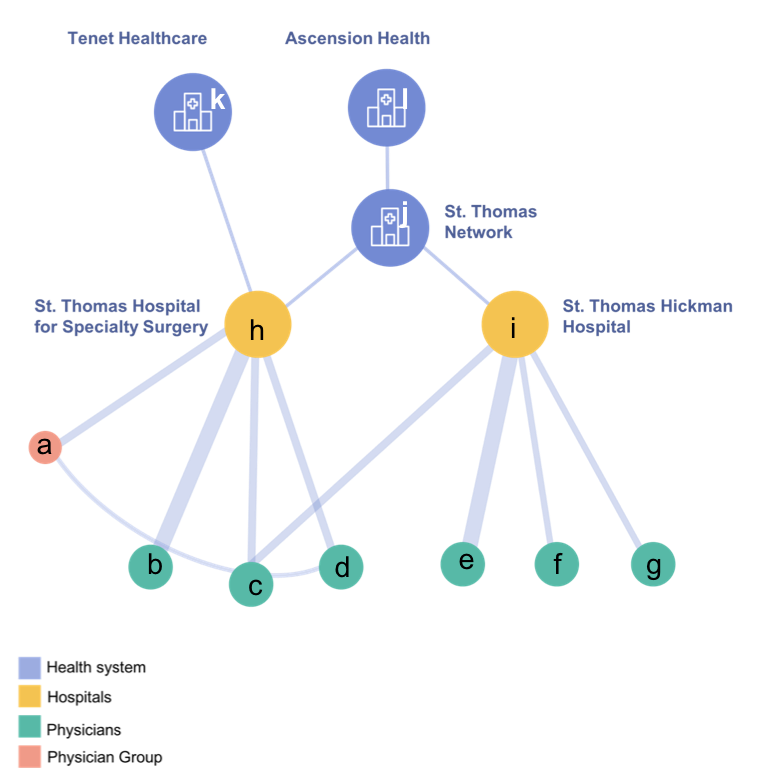Affiliations
An affiliation in Healthbase implies a relationship between entities, HCOs (Healthcare Organizations) and individuals, HCPs (Healthcare professionals). An affiliation can be one of following types -
WORKS_AT: An HCP who works at an HCOAFFILIATED: HCP to PhysicianGroup relationshipIS_LINKED_TO: Parent entity of an HCO/HCPACO_CONTRACTED: ACO contract relationshipsOWNED_BY: HCO ownership relationship derived from regulatory filings. These in turn, can be one of -OwnedManagedLeasedAffiliatedPartnershipJV
Tied to each relationship is also a score (from 1-100) that indicates how strong that relationship is. Healthbase calculate scores based on multiple factors. These include:
- Ownership relationship between two entities (HCO or HCP). Ownership information is derived from multiple sources including regulatory filings, deep web crawls and other sources.
- Real-world claims data: By analyzing patterns across millions of claims on a real-time basis, Healthbase dynamically predicts strengths between entities
Affiliations follow a hierarchical graph structure. As the figure below shows, relationships between HCOs and HCPs aren’t always simple. Healthbase captures the links along with the strength of these linkages. The algorithm also “rolls-up” every entity to a parent, based on certain criteria (e.g. ownership or clinical relationship)

If you flatten this out as links, it looks like the table below. Healthbase’s affiliations tables are based on this flattened link structure
| node_1 | node_2 | score |
|---|---|---|
| a | h | 30 |
| b | h | 90 |
| c | h | 30 |
| d | h | 30 |
| a | d | 20 |
| c | i | 50 |
| e | i | 90 |
| f | i | 30 |
| g | i | 30 |
| h | k | 100 |
| h | j | 100 |
| i | j | 100 |
| j | l | 100 |
Depending on your use-case, you can use one of 4 tables to examine relationships. Additionally, for our power users we also provide access to a graph database which allows you to run powerful queries which can fully exploit the richness of healthbase data.
1. 1. Affiliations
This table is a comprehensive list of entity affiliation relationships leveraging fewer datasets including regulatory documents and other sources. Affiliations are listed with scores and relationship type
- HCP - Hospital/Physician Group
- HCO - HCO
Relationship types: The following types of relationships are defined between entities:
WORKS_AT: HCP to HCO working relationshipsAFFILIATED: HCP to PhysicianGroup affiliationIS_LINKED_TO: Entity parent affiliationsACO_CONTRACTED: ACO contract relationshipsOWNED_BY: HCO ownership relationship derived from regulatory filingsOwnedManagedLeasedAffiliatedPartnershipJV
2. 2. Affiliations Advanced
This table is a comprehensive list of all entity affiliation relationships leveraging multiple datasets including real-time claims, regulatory documents and much more. Affiliations listed with scores and relationship type
- HCP - HCO
- HCO - HCO
- HCO - HCP
Relationship types: The following types of relationships are defined between entities:
AFFILIATED: HCP to PhysicianGroup affiliationIS_LINKED_TO: Entity parent affiliationsWORKS_AT: Working relationships for HCP’s derived from claims and other sourcesBILLS_TO: Billing relationships derived from claimsACO_CONTRACTED: ACO contract relationshipsOWNED_BY: HCO ownership relationship derived from regulatory filingsOwnedManagedLeasedAffiliatedPartnershipJV
RELATED: HCO ownership relationship.SAME_AS: BusinessEntity with same org_pac_id as a PhysicianGroup
Data affiliation filter: The data criteria as below:
- node_1_healthbase_id is practitioner and score >= 30
- node_1_healthbase_id is facility >= 50.
- Delete the particular record if node_1_healthbase_id or node_2_healthbase_id is rogue Entity .
- Take the backup of affiliation tables before performing the filter option.
--DELETE
BEGIN;
DELETE FROM affiliationsadvanced WHERE node_1_label='rogueentity';
DELETE FROM affiliationsadvanced WHERE node_2_label='rogueentity';
DELETE FROM affiliationsadvanced WHERE node_1_label='practitioner' and score1 < 30;
DELETE FROM affiliationsadvanced WHERE node_1_label != 'practitioner' and score1 < 50;
3. 3. Parent Affiliations
This table lists how strongly an HCP or HCO is connected to a parent. This table includes only details on the final parent and not the intermediaries.
And HCP or HCO could be connected to multiple parents, with strength of the link indicated by the score.
- HCO parent: For an HCO, we derive the final parent with a score between 0-100, 100 being the strongest.
HCP parent:
- Specify
node_1_healthbase_id= HCP ID - Take the
node_2_healthbase_idids for that HCP which have a high score (>75) - Take the resultant set of HCOs which are strongly affiliated to the HCP. Now query the table with
node_1_healthbase_id= HCO ID and it will give a set ofnode_2_healthbase_ids which are the final parents.
- Specify
Data affiliation filter: The data criteria as below:
- node_1_healthbase_id is practitioner and score >= 30
- node_1_healthbase_id is facility >= 50.
- Delete the particular record if node_1_healthbase_id or node_2_healthbase_id is rogue Entity .
- Take the backup of affiliation tables before performing the filter option.
--DELETE
BEGIN;
DELETE FROM parent_affiliations WHERE node_1_healthbase_id like 'RE:%';
DELETE FROM parent_affiliations WHERE node_2_healthbase_id like 'RE:%';
DELETE FROM parent_affiliations WHERE node_1_healthbase_id like 'P:%' and score < 30;
DELETE FROM parent_affiliations WHERE node_1_healthbase_id not like 'P:%' and score < 50;